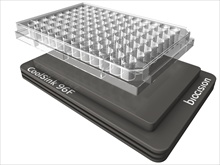Members Login

Channels
Special Offers & Promotions
Do you think your microtitre plates are cold enough on ice? Think again! Only BioCision
 Used as an interface between a microplate and crushed ice, the BioCision CoolSink thermo-conductive plate holder provides fast temperature uniformity.
Used as an interface between a microplate and crushed ice, the BioCision CoolSink thermo-conductive plate holder provides fast temperature uniformity.
Many experimental and clinical applications require low temperature control for culture plates. However, a new Application Note published in BioTechniques1 demonstrates that although it is commonly assumed that a plate in direct contact with crushed ice will rapidly equilibrate below 4ºC, this is not the case. In fact, the unstable nature of crushed ice and insulating air gaps between plate and ice mean that uniform and reproducible cooling are very difficult to achieve. Brian Schryver and Rolf Ehrhardt, MD, PhD found that for 96-well plates placed directly onto crushed ice, the average well temperature was 6.7ºC, significantly above the critical threshold of 4ºC. Furthermore, the well-to-well temperature variation was as wide as 3ºC.
By contrast, placing a plate on BioCision's thermo-conductive CoolSink and then putting the assembly on ice brings all wells to or below 4oC and the well-to-well temperature range was more uniform. The addition of an aqueous conductive medium (ACM) to replace air between the plate and CoolSink surface further enhanced results, with even faster equilibration to a final temperature of 3.3ºC, and less than 1ºC variation between wells.2
According to co-author Brian Schryver, BioCision Vice President, Research and Product Development, ‘CoolSink's precision-engineered "direct contact" stage design eliminates the insulating air gap typically found between plate wells and the resting surface. The module's excellent thermo-conductivity, due to its patented novel alloy construction, gives fast equilibration to below 4ºC, and using an ACM produces near identical well temperatures. This set-up provides a very simple way for researchers to ensure that all their samples are treated uniformly with no "plate edge effect". CoolSink is an ideal tool for increasing the reproducibility of results in a variety of applications, such as cell-based assays, ELISA, FACS staining and analysis, migration or adhesion studies, temperature shift assays or any work with temperature-sensitive biomarkers.'
For further information please visit www.biocision.com/customers.php
1 Brian Schryver and Rolf O. Ehrhardt, MD, PhD, ‘Improved thermal management of microtiter plates using the BioCision CoolSink', BioTechniques 49:845-846, November 2010.
2 Brian Schryver and Rolf O. Ehrhardt, MD, PhD, ‘Improved thermal management of microtiter plates using the BioCision CoolSink', BioTechniques 49:845-846, November 2010, Figure 2.
Media Partners


